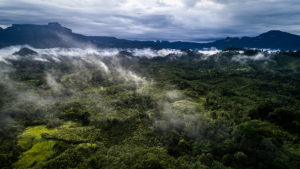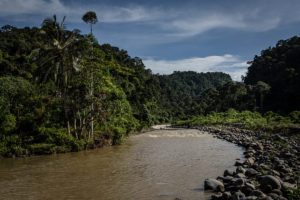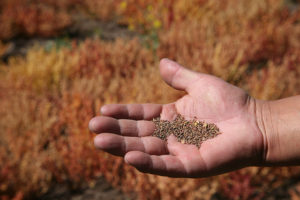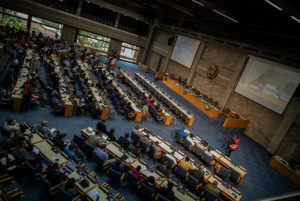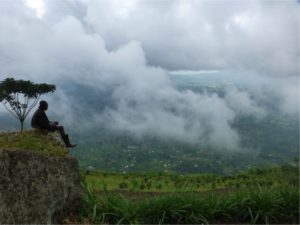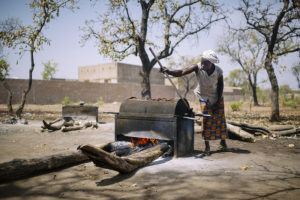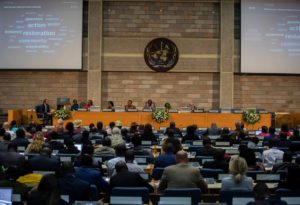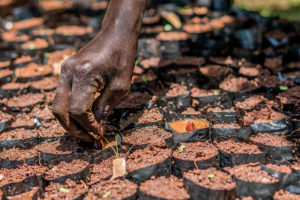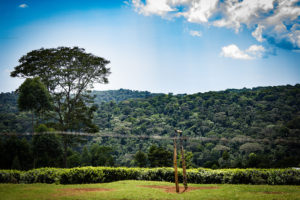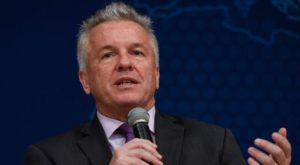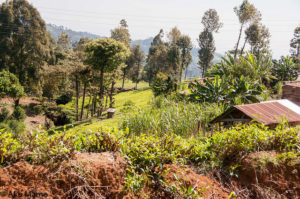
The Global Landscapes Forum in Bonn, Germany, assembled 1,000 participants on-site on 1-2 December, and thousands more online, to go beyond pledges and commitments and spur collective action on securing a more sustainable future for life on this planet.
One of the main messages emerging from the event was that the time to change is now.
“The world needs decisive action,” said director general of the Center for International Forestry Research (CIFOR) Robert Nasi, in his closing remarks. “Research is important, but we now know enough to understand that there is a problem and that we need to solve it – enough to know what we have to do.”
Jochen Flasbarth, who is state secretary of the German Ministry for the Environment, shared Nasi’s sense of urgency: “Without a sustainable land use sector, let’s forget about meeting any of the global climate, biodiversity and sustainable development targets.”
Participants reiterated that business-as-usual will not get landscapes on the track of sustainability, or do it broadly and quickly enough to meet critical biodiversity, climate and development goals. What, then, will get us where we need to go? To answer this question, delegates from governments, academia, NGOs, the private sector and civil society devoted the better part of the two-day forum to presenting specific principles and practical strategies.
“To affect systemic change, we need action from the bottom-up, but also from the top down, so we can get rid of the many that perverse policies that are not in line with the Sustainable Development Goals,” pointed out Louise Luttikholt, director of IFOAM, which is one of 21 GLF Charter members that signed a commitment to the GLF mission at the event. Good governance, targeted policies, and adequate institutional and legal frameworks are essential, noted participants, but the public sector cannot power the sustainable landscape revolution alone.
For assistant secretary-general of UN Environment Satya S. Tripathi, there is no way around the fact that private finance and the private sector are going to play a key role in creating sustainable landscapes. “This is why we need to step out of our comfort zone and find ways to collaborate with private actors, even with those who are misbehaving, so we can get them on the right track,” he said.
The role of private finance was highlighted in an all-women finance plenary as well. We must accept that public investment has a role, said Jane Feehan from the European Investment Bank, but that the bulk of ‘green’ funding must come from private institutions and businesses.
Watch: Satya S. Tripathi at the Closing Plenary 2018
SUSTAINABLE BUSINESS MODELS
Tapping into the potential of sustainable business models and changing consumer behavior are some of the key approaches championed by researchers, governments and international organizations alike. Several initiatives are now emerging to push responsible production and consumption forward, greening both supply chains and mindsets.
“For example, what makes a jurisdiction an attractive destination for companies that want to source sustainable commodities?” queried Gita Syahrani, head of the Sustainable Districts Association secretariat in Indonesia. “We are working to define these enabling conditions so our districts can green their supply chains for commodities such as rubber and palm oil,” she said. As part of this effort, they are collaborating with the Dutch sustainable trade initiative IDH in the creation of the Verified Sourcing Mechanism (VSM).
IDH’s groundbreaking mechanism, which will launch for consultation in July 2019, aims to verify the sustainability of an entire production area – such as a state or a district — so auditing each producer or commodity individually is no longer necessary. “Verified sourcing areas can drive progress because they provide a business model for sustainability that everybody can join,” said Willem Klaassens, IDH senior commodity trade specialist.
The same principle should underpin the restoration of forest landscapes, according to delegates from organizations such as the Food and Agriculture Organization of the UN (FAO), CIFOR and the International Tropical Timber Association (ITTO). “Integrating forest landscape restoration with sustainable wood value chains can lead to greater overall benefits, including increased ecosystem services, forest products and employment opportunities,” said assistant director-general of FAO’s Forestry Department Hiroto Mitsugi.
Watch: Robert Nasi at the Closing Plenary GLF Bonn 2018
MAKING NATURAL CAPITAL COUNT
Nasi from CIFOR noted that the cost of inaction is much higher than the cost of investing – financially, and through other action – in landscape sustainability. “The world is losing an estimated USD 6.3 trillion to land degradation every year; yet, meeting the goal of restoring 300 million hectares of land by 2030 could have a return of USD 7 to 20 for each dollar invested.”
In a recent study, the World Bank tracked the wealth of countries taking into account built, human and natural capital. What they found is that natural capital accounts for an average of 9 percent of wealth globally, but up to 47 percent in low-income countries.
“This means that more efficient management of land resources is key to the sustainable development of countries,” said Karin Kemper, senior director for the Environment and Natural Resources Global Practice at the World Bank. “To understand how countries become wealthier in a sustainable way, we need to go beyond their gross domestic product and take into account their natural capital.”
Better integrating landscape interventions into national economic development plans can make strides in changing consumers’ behavior; increasing the transparency of supply chains; and equipping producers to develop projects that are investment-ready and financially attractive.
Then there is the cross-cutting issue of rights, and “particularly, those of local communities and indigenous people, whose territories host 80 percent of the world’s biodiversity,” said co-convenor of the Indigenous Peoples Major Group for Sustainable Development Joan Carling.
In the face of a growing global population and climate change, implementing these and other strategies cannot wait, believes Stefan Schmitz, deputy director-general and commissioner for the One World – No Hunger initiative of the German Federal Ministry for Economic Cooperation and Development (BMZ).”We need to empower people to achieve sustainable food systems, bearing in mind they live in spaces, not in sectors. We need to shift from thinking in sectors to thinking in landscapes.”
FROM INDIVIDUAL TO SYSTEMIC CHANGE
The GLF convened large organizations, but also shone light on individuals, young and old, who have braved disbelief and put their lives on the line to reclaim healthy landscapes around the world. Right Livelihood Award laureates Yacouba Sawadogo and Tony Rinaudo are two of them.
Sawadogo, known as ‘the man who stopped the desert,’ has devoted his life to restoring land fertility in his native Burkina Faso, inspiring many other farmers in this and other countries to do the same. “I gave up everything, all my time and belongings, to dedicate myself to the land. At 72, I only own a donkey and a cart. My one wealth is the forest I planted,” he said in the opening plenary.
Rinaudo, who is natural resources management specialist at World Vision, has been championing a restoration technique known as farmer-managed natural regeneration (FMNR). After working for decades with countries such as Niger, he came to a realization: “The first step to re-greening landscapes is re-greening mindscapes.”
The path may be long, but the thousands of organizations and individuals who participated in the GLF are already on their way.
By Gloria Pallares, originally published at GLF’s Landscape News.
For more on GLF Bonn 2018, read Landscape News’ highlights from Day 1 and Day 2.












